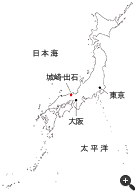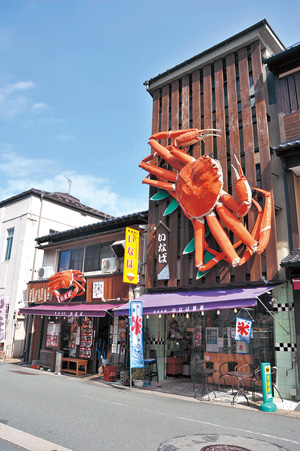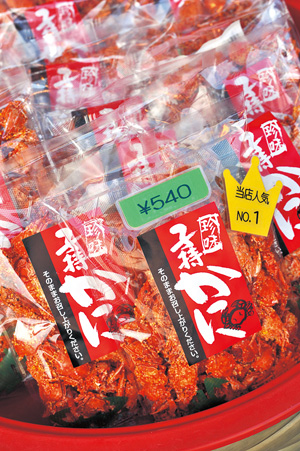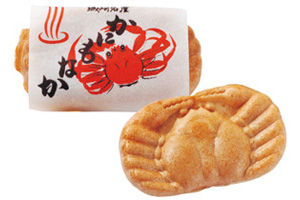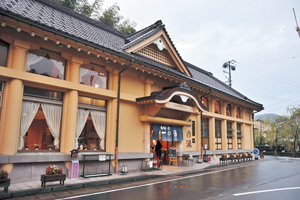niponica is a web magazine that introduces modern Japan to people all over the world.
2014 No.14

To read the e-book you need to have JavaScript enabled in your browser and a free Flash Player plug-in from Adobe Systems Inc. installed.
 Strolling Japan
Strolling Japan
Photos by Ito Chiharu and Nishiyama Shogo Maps by Oguro Kenji Collaboration: Nishimura-ya Honkan and Soba Fuji

Atago Bridge in Kinosaki
Kinosaki Onsen Spa is ranked as one of the best hot spring areas in the Kansai (Kobe-Osaka-Kyoto) region. It is in Kinosaki-cho, Toyo’oka City, in northeastern Hyogo Prefecture.
Hot mineral waters first pushed their way to the surface about 1,300 years ago, and they are known for their therapeutic qualities. An illustrious author even set one of his novels here, and people from all walks of life have long had a high regard for Kinosaki Onsen.
The area is renowned for its seven soto-yu. A soto-yu (literally, “outside hot water”) is a public bathing facility that is open to everyone, not managed like a traditional ryokan inn, which only serves guests who stay the night. Kinosaki’s soto-yu baths are located along both sides of the Otani River, which runs through the middle of the town. Each bath has its own story of origins, and a reason to be proud of its acclaimed status. Come find the one that best suits your fancy.
When rambling about, try wearing a yukata and geta, the “standard attire” for spa goers in Kinosaki. A yukata is a simple kimono-like garment worn with little underneath it, while geta are wooden clogs with crosswise supports and thongs for the toes. When dusk falls and lights brighten the walkways along the river, the willow trees and arched bridges create their own scenes of beauty. Strolling in yukata past the soto-yu baths in softly lit surroundings brings a feeling of contentment to the mind and body.
On the banks of the Otani River, there are a number of traditional ryokan inns. Some have an illustrious past, having welcomed travelers for decades. Most have uchi-yu (inside baths) with interesting decors, providing a different type of experience from the soto-yu baths.
When winter comes, the best gastronomical experience is crab, the king of Japanese winter cuisine. Snow crab caught here, called matsuba-gani, excel in their ample supply of meat and their subtly sweet taste.
A favorite daytime pastime in Kinosaki is riding the ropeway to the top of Mount Daishi, where you will find a soto-yu called Kono-yu. From the mountaintop lookout are glorious views of the spa town, distant mountain ranges, and the Maruyama River flowing to the Sea of Japan. How each part of this panorama displays itself depends on the season and weather.

In Kinosaki, expect to see people strolling about wearing yukata and geta clogs.
The street from Kinosaki Onsen Station to the hot spring district features restaurants serving crab (a local specialty).
Crab-shaped monaka (a tasty treat unique to Japan, made from rice cake dough stuffed with an bean paste)
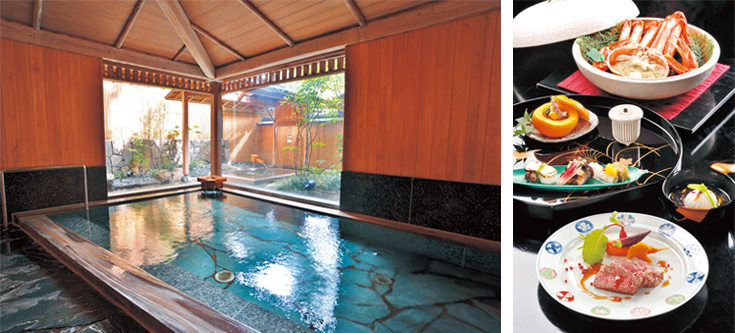
Nishimura-ya Honkan’s history goes back 150 years. The inn’s hot spring bath and cuisine leave nothing to be desired.
Left: The bathhouse’s hinoki cypress wood emits a scent bathers find refreshing.
Right: A feast for the eye. Morsels of famed Tajima beef (Kuroge wagyu of Hyogo Prefecture), set off nicely with crab.




